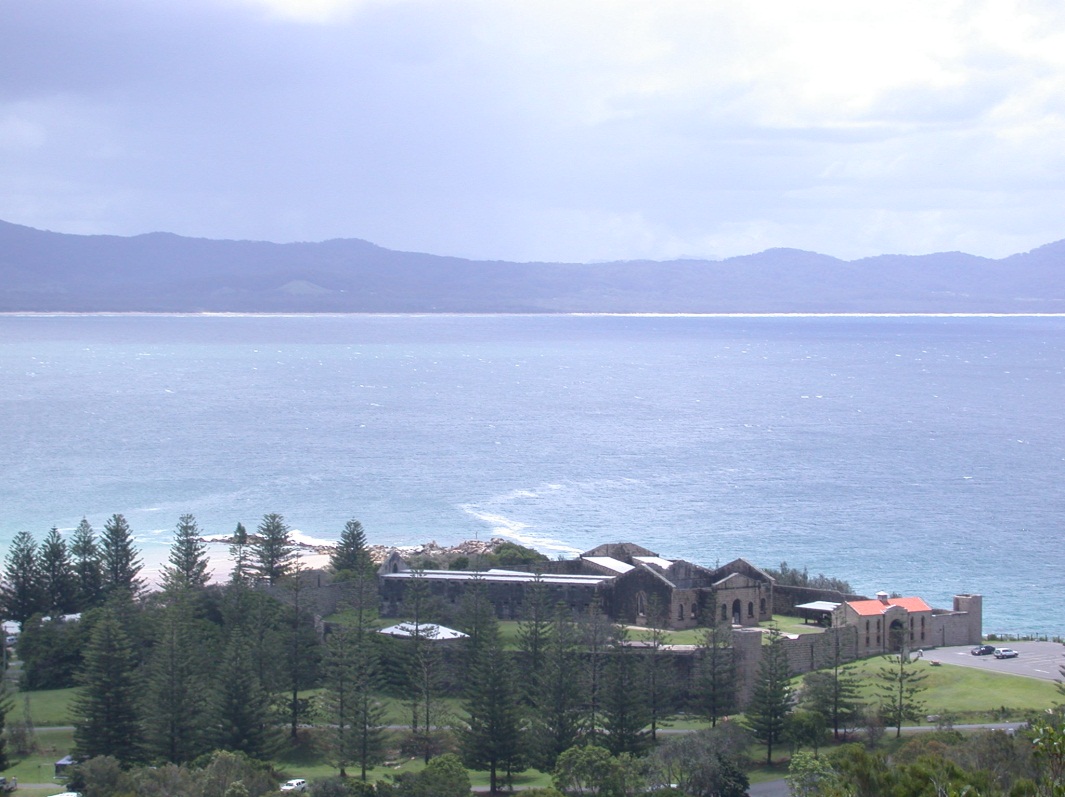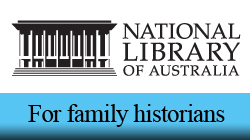by Mark Schuster (Brisbane, QLD)
‘Day in day out, nothing but this terrible ancestral castle, the sea and nothing but the sea, and the overwhelming unfulfilled yearning for freedom and our home country.’ (Martin Trojan, 1922)
How did a large number of German internees and a small local German-Australian group of families fare in a basically Anglo-centric rural coastal community during the years of the Great War (1914-1918)? This was an issue that has often crossed my mind during the last few decades. In this short personal essay I hope to provide some leads that may assist in ‘sorting out’ this complex question.
My own family circumstances and a well-researched historical novel are the basis of this work and on a recent visit to Arakoon, near the historic Trial Bay Gaol, I was able to start to put the jigsaw pieces into this elusive puzzle.
Back in the days when I was married, many pleasant beach-side holidays were spent at South West Rocks, the small seaside resort at the mouth of the Macleay River, in northern New South Wales. We always stayed at the family residence where my mother-in-law, Gwen Zann, had grown up. Gwen’s parents were both well-respected, and community-minded citizens of ‘The Rocks’. Her Dad, Frank Range, operated Spencers Creek Quarry, and built many of the roads throughout the Macleay district, including the steep roads up the notorious Comboyne Plateau. In addition he was president of the local Surf Lifesaving Club for more than 20 years. He piloted the river drogher, ‘The Urunga’, for many years. His wife, Adelaide, (nee O’Halloran) was a local girl from Frederickton, who was very committed to helping the community. Both Frank and Adelaide were commanding figures in The Rocks community and during frequent large flooding events along the Macleay were instrumental in many rescue efforts.
The Range family resided at The Rocks from the early 20s until when Adelaide Range passed away in 1988. Their house in Paragon Avenue was the place to ‘drop in for a yarn and a cuppa’. Frank Range was of German descent, both his grandparents having migrated from the Kassel area of the then German Empire in the 1850s – 1860s. On his paternal side, his Dad was Harry (Herman) Range. The family had anglicised their name from Runge. His maternal side were the Koenig lineage – who also anglicised their name to King. (However, Herman Joseph Koenig still used the Koenig surname when buried at West Kempsey in 1881). Gwen told me a family story about the Koenig’s when they first pioneered their ‘selection’ on the Macleay. One day, soon after their slab hut was built, the family were sitting down for a roast lunch when who should waddle in but a very large goanna. He quickly darted to the bench and grabbed the remnants of the roast – but not before Grossvater Koenig threw a fork which stuck in the reptile’s back. The goanna headed for the safety of the bush, with the roast and the much valued fork. The family searched for that goanna, and the fork, for many years without success. If that fork is found in the future it is unlikely that the finder will not know its humorous history and how it came to be lost in the bush!
When on these family holidays we would often visit the then derelict large stone gaol which sat on the imposing headland overlooking Trial Bay. Research over the next few years then revealed its fascinating history. Construction commenced in 1876 as a Public Works Gaol but it was not completed until 1886 due to difficulties in working the hard granite stone and contractual problems. The early prisoners were paid a small wage to construct a breakwater to make Trial Bay a safe harbourage for vessels. Although an imposing ‘castle’ style structure its main claim to fame came in the years 1915-1918 when it housed 580 German internees – most of them German ‘Nationals’ from the many corners of the Pacific and from various locations in Australia. Many of these men were academics, businessmen or from very distinguished backgrounds. As just one example, the distinguished medical surgeon Dr Max Herz was an internee at Trial Bay and many locals were treated with his kindness and medical talents. Dr Herz was a world acclaimed orthopaedic surgeon who after WW1 resided and practiced in Sydney. Trial Bay had theatrical groups and musical ensembles – string bands and a brass band.
German internees marching from Jerseyville Wharf to Trial Bay Gaol on arrival in 1915.
There can be no doubt that the huge German presence at Trial Bay during the War years 1915-1918 must have caused animosity in the local communities along the Macleay. It must be remembered that many young soldiers enlisted from these small rural communities and that the presence of the German internees must have been a cause for hostility.
Local author Gwen Kelly wrote a historically-based novel entitled Álways Afternoon’ which details the lives of a number of the internees at Trial Bay, local families and also two German-Australian families. Although the novel is based around a romance between an internee (young Franz Muller) and a local Arakoon girl (Freda Kennon). Also involved is a local German-Australian farming family – the Schreibers. Old Kurt Schreiber was born in Germany and came to the Macleay as a boy. His two sons, Erich and Tom, left the family farm to fight with the AIF in Europe. The ‘Monument- atop the hill overlooking the Pacific Ocean at Trial Bay. The story of the German monument at Trial Bay symbolises these mounting tensions and the simmering attitudes of the local Anglo-centric community.
In 1917 the internees were given permission to erect a monument in memory of their compatriots who had died during internment. They cut blocks of granite from the prison quarry and hired Jack Croad of Clybucca, with his bullock team, to take the granite up the steep slope of the hill behind the prison.
On the crest of the hill, overlooking the emerald Pacific Ocean, they built a 20 foot high granite obelisk. Four graves, inscribed with the names of the five internees who died during the internment period, formed a cross at the base of the monument. The impressive monument, and the German graves, formed a very visible landmark and caused bitterness in the Macleay district. In early July 1919, after an earlier attempt, the monument was blown ásunder’- possibly by a group of returned servicemen. The column was reduced to a pile of stones, but the graves at the base were undamaged. The locals welcomed its demolition and a large number of sightseers visited the spot.
Thomas Adamson, the last governor of Trial Bay, wrote: ‘Tonight I read with gratification of the destruction of the German monument at Trial Bay, built upon a spur of the Smoky Cape range…. I have a son buried upon the spur, and two sons absent at war, one, an ANZAC, born at Trial Bay, away five years.’
In 1959, the German Consulate, with assistance from the Macleay Shire Council and Kempsey Rotary Club, paid for the restoration of the monument. Today the monument again stands in its lonely scenic spot, high on the hill, overlooking the ocean and surrounded by wildflowers. The inscription of the stone reads: ‘To the memory of our dead. Built by interned comrades at Trial Bay Prison during World War 1914-1919’.
But the question that is still remains, and maybe the hardest to answer, is how were the ‘local’ Germans (i.e. the German-Australian community) viewed in this volatile situation, and more specifically were there any negative implications for those locals such as Frank Range and his family. In her historical novel Álways Afternoon’, Gwen Kelly uses the old German-Australian farmer, Kurt Schreiber, to illustrate attitudes of the authorities and community. Kurt, the family patriarch, was born in Munich, but farmed along the Macleay for most of his life. Even though his sons, Tom and Erich, were fighting for the AIF, his apparent loyalty and outspoken comments regarding Germany led to his internment at Trial Bay. It is fact that many German-Australians, who were suspected of loyalty to Germany, were interned in WW1 at a number of locations. I’m not sure how many German-Australians, if any, as contrasted to German Nationals (from the Pacific and in Australia), were housed at Trial Bay. This may be a fascinating topic for further research. However Gwen Kelly provides us with an insight into the ‘German-Australian’ context in the Macleay district. Early in the novel (p 15) she states: “Erich’s people, of course, were German, but it didn’t count. They had migrated to Australia years ago to escape the Prussians and both boys were dinkum Aussies, born in Kempsey. Not like the Huns they were bringing to Trial Bay.” This paragraph does illustrate that the ‘locals’ generally accepted those of German descendant as loyal Australians, whereas German ‘Nationals’ were viewed very differently. However, German-Australian farmers who were born in the Fatherland may have been viewed in quite a different light – particularly those who were vocal of their German heritage – as illustrated by the father, Kurt Schreiber, who was interned. Many of the German-Australians were proud of their heritage, as returned veteran and German-Australian Tom stated as illustrated in Álways Afternoon’, where he is asked to participate in blowing up the monument (p 258): Slowly, Tom put down his beer. “Count me out”, he said, “I’m going bush tomorrow to forget there ever was a bloody war…. Anyway, my name’s Schreiber, remember. Good old German name. As it happens my old man’s name is on a slab up there”. Although Frank Range, of German descent, didn’t reside at The Rocks during WW1, how was he looked upon just after the Great War and also during the latter times of anti-German sentiment in WW2? It must be remembered that resentments of the Trial Bay internees would have been long standing – and may have even lingered until the 1940s. The answer to this question is easily answered.
Although Frank’s ancestors had migrated from Germany in the late 1800s, he, and his wife, were always considered as leaders in their small community. During World War 2 he worked extensively for the Public Fence Construction Authority – constructing and upgrading the transport corridors required for defence of our Nation. Also in holding a number of prominent community positions, particularly being instrumental in the formation of the local Surf Lifesaving Club, held him in excellent public opinion. This meant he was locally regarded not as a German-Australian, but ‘top fella’ Frank Range – a true local community leader. His loyalty was to his community. Other German-Australian families, with mixed loyalties, may have suffered from community angst and resentment. However this was never the case for the community-minded Range family.
It seems more than just chance that I should have the opportunity to write about Trial Bay, the German internments and the German-Australian rural community along the beautiful Macleay River. As I write from our secluded beach house in the lovely Arakoon bushland, within walking distance of the old gaol, it is always afternoon’. The other day I walked down Paragon Avenue. Like Frank and Adelaide Range, the old colonial house has long gone and the prime land at ‘The Rocks’ is now up for sale. Any remaining German-Australian farming families in this region are today very Australian – and traces of any German traits are just a faded memory. However the memory of all these issues is still in the minds of the receding older generation.
Arakoon, Trial Bay and South West Rocks – a unique and fascinating history for such a beautiful region on the north coast of New South Wales.





8 Comments